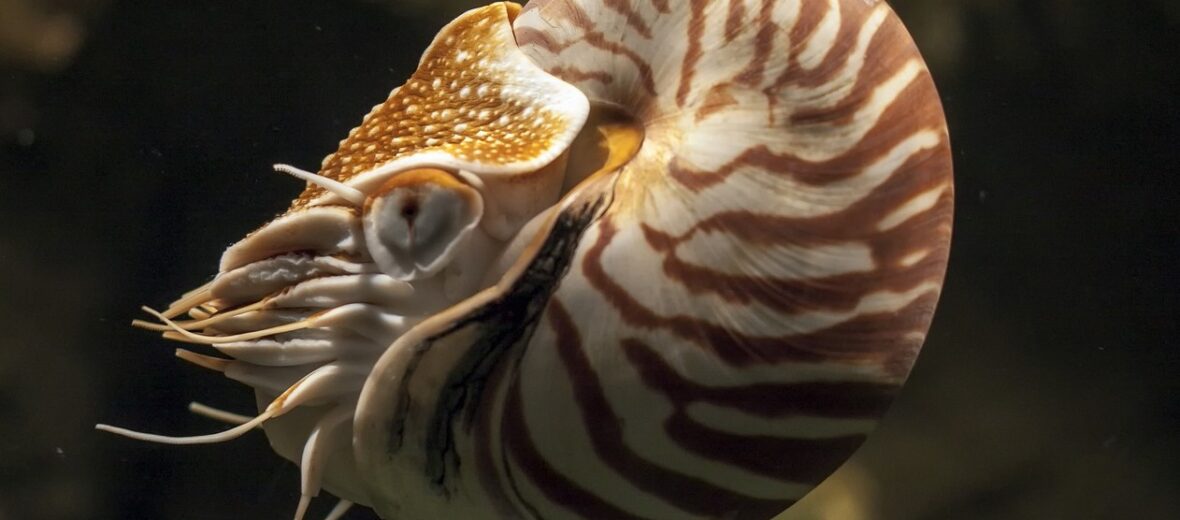
The nautilus, aka chambered nautilus or pearly nautilus, is a cephalopod. Which means it’s a member of the squid and octopus family. They can be found in tropical waters around the Indian and Pacific oceans, near the coast of Australia, Japan, Fiji, New Caledonia, and more locales. These peculiar creatures like coral reef living and can be found at depths of up to 2,000 feet. Due to their beautiful shells, they are often collected for sale in markets as trinkets. These critters are also at risk due to over-fishing, climate change, and water pollution. The chambered nautilus is listed as Threatened by the IUCN. Other nautiluses are listed as Data Deficient.
First the Stats…
Scientific name: Nautilidae
Weight: Up to 2.8 lbs.
Length: Up to 12 inches across
Lifespan: Up to 20 years
Now on to the Facts!
1.) There are 6 known species of nautilus left in the wild to date.
2.) Unlike octopuses, these critters aren’t too bright. It was once surmised that they don’t even possess the capability for memory at all.
3.) Nautilus shells have an arrangement of chambers connected by a siphuncle (pronounced sigh-funk-el). This is a tube made of tissue. Newborns begin life with just 4 chambers. But more develop as they age. Adults can have around 30+ chambers!
4.) Each chamber houses a cocktail of sea water and gas which is regulated by the siphuncle.
5.) In order to descend, the siphuncle fills some of the chambers with chlorine & sodium ions. This weighs down the creature and it descends. In order to ascend, the siphuncle siphons out the chlorine & sodium from the chambers, which causes the argon-nitrogen gas bubbles to diffuse and lightens the shell.
But wait, there’s more on the nautilus!
6.) In order to get going fast, they will utilize jet-propulsion. A siphon points in the opposite direction that they want to go in. A strong jet of water is forced out of the siphon and away they go.
7.) A nautilus has a parrot-like beak, like squids and octopuses, which slices their food. Another organ, called a radula, grinds the food up to make it easier to swallow.
Did you know…?
A nautilus has upwards of 90 long tentacles. Each is lined with ridges and grooves that help them to hold onto prey.
8.) Depths below 2,575 feet will implode their shell, killing them instantly.
9.) They prey and feast on crustaceans, fish, and carrion (dead animals).
10.) Due to their poor eyesight (they are only able to distinguish between light and dark), they rely instead on scent to hunt.
But wait, there’s still more on the nautilus!
11.) At the tips of their tentacles, they have tiny hairs called cilia that help them hold onto prey.
12.) The nautilus is primarily nocturnal. They spend their days in deeper water and come to the shallower water levels at night to feed.
Did you know…?
Rather than follow the semelparity (reproducing once and dying) of other cephalopods, the nautilus can reproduce numerous times during their lifetime.
13.) Sharks, turtles, and octopuses all prey on these cool critters.
14.) The Allonautilus scrobiculatus uses a thick slimy coating to protect itself from being eaten.
15.) Females lay up to 12 huge eggs each breeding season. Their eggs are among the largest in relation to body size of any other known animal. They measure up to 1.5 inches long.
But wait, there’s a little more on the nautilus!
16.) The female will affix her eggs to a hard surface where they will develop in about 9 – 12 months.
17.) Males have a couple of tentacles that act as sexual organs that deliver sperm packages into the female’s body.
Did you know…?
Nautilus comes from the Latin word meaning sailor.
18.) Males outnumber females by a 75% to 25% ratio.
19.) Nautiluses have been around, practically unchanged, for around 500 million years.
20.) Unlike its cephalopod cousins, nautiluses can’t squirt ink.
Now a Short Nautilus Video!
Also, check out the Critter Science YouTube channel. Videos added frequently!
Want to suggest a critter for me to write about? Let me know here.



